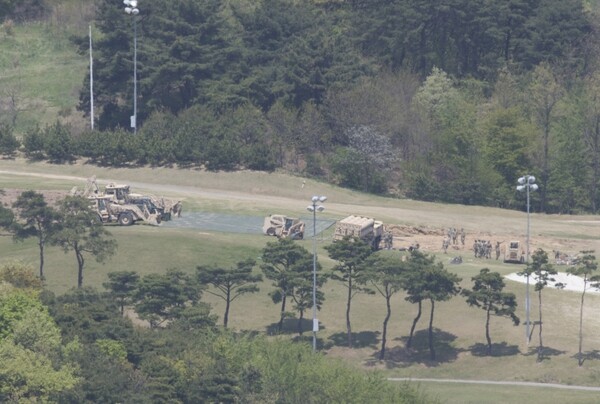hankyoreh
Links to other country sites 다른 나라 사이트 링크
THAAD missile defense system to become operational soon

The THAAD missile defense system that US Forces Korea suddenly deployed to the Seongju Golf Course in North Gyeongsang Province is to begin operations soon. The announcement that THAAD will soon become fully operational before an environmental impact assessment has even been conducted is likely to spark further controversy over the deployment.
During a regular press briefing on the morning of Apr. 27, South Korean Defense Ministry spokesperson Moon Sang-gyun explained remarks by Admiral Henry Harris, commander of the US Pacific Command, as meaning that THAAD would be “actually” operational, not just on a trial basis. During an appearance before the US House Armed Services Committee on Apr. 26, Harris said that THAAD would be operational before long. “What this means is that some of the launchers, the fire control station and the radar, which are currently on site, will be connected and acquire initial operational capability,” Moon added.
Moon also noted that Harris “didn’t say [THAAD] would actually become operational today,” explaining that “there are several remaining steps before it can become [fully] operational.”
Following the Defense Ministry’s briefing, numerous analysts concluded that the THAAD system was basically battle ready. “They used the phrase ‘actually operational’ because it’s deployed and ready for action,” one source in the Defense Ministry confirmed. But since the interceptor missiles have reportedly not been delivered yet, the “initial operational capability” that the Ministry mentioned is presumed to mean having the ability to detect, identify and target incoming missiles, without actually intercepting them.
With the clock ticking before THAAD begins its normal operations, it’s becoming more likely that the environmental impact assessment will be a mere formality. “In line with the concept of field deployment, the system was deployed without any facility construction. We’re currently drafting the environmental impact assessment, and we’ll deliberate this with the Ministry of Environment,” Moon said. But he also said that field operation is possible without an environmental impact assessment, hinting that THAAD could become operational even without such an assessment.
“In order to alleviate concerns” about the X-band radar, which China and Seongju residents have taken issue with, Moon said that “tests will be run on the actual equipment to determine the safety of the electromagnetic waves, and the results will be made public.” Moon expressed the government’s conviction that THAAD will become fully operational even after the environmental impact assessment.
“An environmental impact assessment has to be done in advance in order to determine the impact on the environment and to devise ways to reduce that impact. The declaration that they’re going to activate the system before doing an environmental impact assessment means they don’t plan to conduct an assessment at all,” said Kim Jin-hyeong, a lawyer with MINBYUN-Lawyers for a Democratic Society.
By Kim Ji-eun, staff reporter and Yi Yong-in, Washington correspondent
Please direct questions or comments to [english@hani.co.kr]

Editorial・opinion
![[Column] The state is back — but is it in business? [Column] The state is back — but is it in business?](https://flexible.img.hani.co.kr/flexible/normal/500/300/imgdb/original/2024/0506/8217149564092725.jpg) [Column] The state is back — but is it in business?
[Column] The state is back — but is it in business?![[Column] Life on our Trisolaris [Column] Life on our Trisolaris](https://flexible.img.hani.co.kr/flexible/normal/500/300/imgdb/original/2024/0505/4817148682278544.jpg) [Column] Life on our Trisolaris
[Column] Life on our Trisolaris- [Editorial] Penalties for airing allegations against Korea’s first lady endanger free press
- [Editorial] Yoon must halt procurement of SM-3 interceptor missiles
- [Guest essay] Maybe Korea’s rapid population decline is an opportunity, not a crisis
- [Column] Can Yoon steer diplomacy with Russia, China back on track?
- [Column] Season 2 of special prosecutor probe may be coming to Korea soon
- [Column] Park Geun-hye déjà vu in Yoon Suk-yeol
- [Editorial] New weight of N. Korea’s nuclear threats makes dialogue all the more urgent
- [Guest essay] The real reason Korea’s new right wants to dub Rhee a founding father
Most viewed articles
- 1[Column] Why Korea’s hard right is fated to lose
- 2Amid US-China clash, Korea must remember its failures in the 19th century, advises scholar
- 3[Column] The state is back — but is it in business?
- 4[Column] Life on our Trisolaris
- 5[Guest essay] Maybe Korea’s rapid population decline is an opportunity, not a crisis
- 6OECD upgrades Korea’s growth forecast from 2.2% to 2.6%
- 7AI is catching up with humans at a ‘shocking’ rate
- 8[Column] Can Yoon steer diplomacy with Russia, China back on track?
- 9[Editorial] Yoon must halt procurement of SM-3 interceptor missiles
- 1060% of young Koreans see no need to have kids after marriage